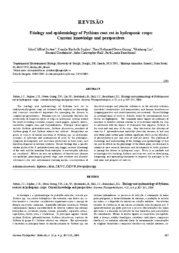Etiology and epidemiology of Pythium root rot in hydroponic crops: current knowledge and perspectives.
Etiology and epidemiology of Pythium root rot in hydroponic crops: current knowledge and perspectives.
Author(s): SUTTON, J. C.; SOPHER, C. R.; OWEN-GOING, T. N.; LIU, W.; GRODZINSKI, B.; HALL, J. C.; BENCHIMOL, R. L.
Summary: The etiology and epidemiology of Pythium root rot in hydroponically-grown crops are reviewed with emphasis on knowledge and concepts considered important for managing the disease in commercial greenhouses. Pythium root rot continually threatens the productivity of numerous kinds of crops in hydroponic systems around the world including cucumber, tomato, sweet pepper, spinach, lettuce, nasturtium, arugula, rose, and chrysanthemum. Principal causal agents include Pythium aphanidermatum, Pythium dissotocum, members of Pythium group F, and Pythium ultimum var. ultimum. Perspectives are given of sources of initial inoculum of Pythium spp. in hydroponic systems, of infection and colonization of roots by the pathogens, symptom development and inoculum production in host roots, and inoculum dispersal in nutrient solutions. Recent findings that a specific elicitor produced by P. aphanidermatum may trigger necrosis (browning) of the roots and the transition from biotrophic to necrotrophic infection are considered. Effects on root rot epidemics of host factors (disease susceptibility, phenological growth stage, root exudates and phenolic substances), the root environment (rooting media, concentrations of dissolved oxygen and phenolic substances in the nutrient solution, microbial communities and temperature) and human interferences (cropping practices and control measures) are reviewed. Recent findings on predisposition of roots to Pythium attack by environmental stress factors are highlighted. The commonly minor impact on epidemics of measures to disinfest nutrient solution as it recirculates outside the crop is contrasted with the impact of treatments that suppress Pythium in the roots and root zone of the crop. New discoveries that infection of roots by P. aphanidermatum markedly slows the increase in leaf area and whole-plant carbon gain without significant effect on the efficiency of photosynthesis per unit area of leaf are noted. The platform of knowledge and understanding of the etiology and epidemiology of root rot, and its effects on the physiology of the whole plant, are discussed in relation to new research directions and development of better practices to manage the disease in hydroponic crops. Focus is on methods and technologies for tracking Pythium and root rot, and on developing, integrating, and optimizing treatments to suppress the pathogen in the root zone and progress of root rot.
Publication year: 2006
Types of publication: Journal article
Unit: Embrapa Eastern Amazon
Keywords: Ambiente radicular, Crescimento da parte aérea, Desinfecção, Epidemiologia da podridão radicular, Fatores patogênicos, Fotossíntese por unidade de área foliar, Interferências humanas, Podridão Radicular, Produção de inóculo em raízes, Pythium Aphanidermatum, Pythium dissotocum, Sistemas hidropônicos, Solução Nutritiva, Zona radicular
Observation
Some of Embrapa's publications are published as ePub files. To read them, use or download one of the following free software options to your computer or mobile device. Android: Google Play Books; IOS: iBooks; Windows and Linux: Calibre.
Access other publications
Access the Agricultural Research Database (BDPA) to consult Embrapa's full library collection and records.
Visit Embrapa Bookstore to purchase books and other publications sold by Embrapa.

